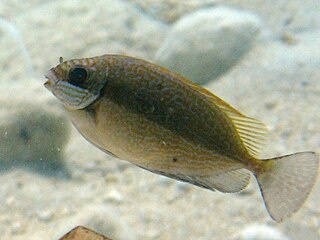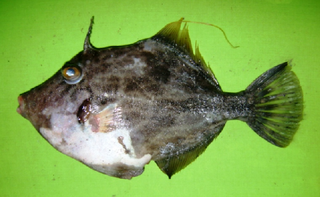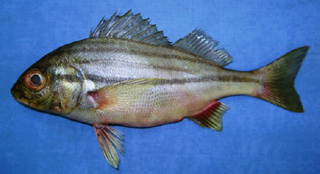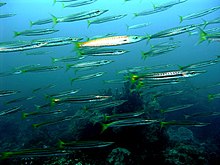
A barracuda is a large, predatory, ray-finned fish known for its fearsome appearance and ferocious behaviour. The barracuda is a saltwater fish of the genus Sphyraena, the only genus in the family Sphyraenidae, which was named by Constantine Samuel Rafinesque in 1815. It is found in tropical and subtropical oceans worldwide ranging from the eastern border of the Atlantic Ocean to the Red Sea, on its western border the Caribbean Sea, and in tropical areas of the Pacific Ocean. Barracudas reside near the top of the water and near coral reefs and sea grasses. Barracudas are targeted by sport-fishing enthusiasts.

The Australian barracuda, arrow barracuda, Australian sea pike, sea pike, snook, or shortfin barracuda, Sphyraena novaehollandiae, is a barracuda of the genus Sphyraena which occurs in the south-western Pacific Ocean.

The hardyhead silverside, also known as the broad-banded hardyhead, broad-banded silverside, Capricorn hardyhead, pitted hardyhead, robust hardyhead, robust silverside, slender hardyhead and wide-banded hardyhead silverside, is a silverside of the family Atherinidae. It occurs in the Indo-Pacific near the surface as well as in the Mediterranean, having invaded as a Lessepsian migrant through the Suez Canal.
The southern sennet is an ocean-going species of game fish in the barracuda family, Sphyraenidae. It was described by the Cuban zoologist Felipe Poey. The description was part of a two-volume work, which Poey published in 1860, entitled Historia Natural de la Isla de Cuba or Natural History of the Island of Cuba. Southern sennet are sometimes used as a food fish, and marketed either fresh or frozen. Although they are generally harmless, Southern sennet have been linked to ciguatera poisoning.
The Guachanche barracuda, is an ocean-going species of game fish in the barracuda family, Sphyraenidae. It was described by the French zoologist Georges Cuvier in 1829. The description was part of the second edition of Le Règne Animal, or The Animal Kingdom. Guachanche barracuda are also known simply as guaguanche throughout much of the Caribbean. When used for food, Guaguanche barracuda are usually sold fresh or salted.

Sphyraena argentea is a predatory fish found in the northeast Pacific Ocean. They range from Cabo San Lucas, Baja California to Washington. However, they are not common north of Point Conception in Santa Barbara County, California. They can reach a length of about 1.2 metres (3.9 ft) and a weight of about 6.8 kilograms (15 lb). California barracuda are very popular sport fish in Southern California.

Caesio is a genus of marine ray-finned fish, fusiliers belonging to the family Caesionidae. They are native to the Indian Ocean and the western Pacific Ocean, although one species has invaded the eastern Mediterranean Sea through the Suez Canal by Lessepsian migration.

The dusky spinefoot, also known the squaretail rabbitfish,is a species of marine ray-finned fish, a rabbitfish belonging to the family Siganidae. It is native to the western Indian Ocean which has spread to the Mediterranean Sea through the Suez Canal. Its fin spines contain venom. It is regarded as a food fish.

The Indian Scad, also known as the Northern mackerel scad, round scad, Russell's mackerel scad, slender scad or the three lined grunter, is a species of ray-finned fish of the genus Decapterus which is part of the family Carangidae and which occurs in the Indian Ocean. It has colonised the eastern Mediterranean through the Suez Canal. It is an important species in coastal fisheries throughout its range.

The Blackfin barracuda, also known as the Chevron barracuda, is a species of barracuda that ranges from the Red Sea and East Africa to the Indo and Western Pacific and as far as French Polynesia.
Sphyraena sphyraena, also known as the European barracuda or Mediterranean barracuda, is a ray-finned predatory fish of the Mediterranean basin and the warmer waters of the Atlantic Ocean.

Ostorhinchus fasciatus, commonly known as the broad-banded cardinalfish, is a marine fish native to the Indian and Pacific Oceans which is a Lessepsian migrant to the eastern Mediterranean through the Suez Canal from the Red Sea, it was first recorded off Israel in 2008 and has now reached the southern coast of Turkey. It has a number of vernacular names including barred striped cardinalfish, four-banded soldier-fish, striped cardinalfish and twostripe cardinalfish.

Sphyraena helleri, the Heller's barracuda, is a schooling species of barracuda in the family Sphyraenidae.

Sphyraena viridensis, the yellowmouth barracuda or yellow barracuda is a predatory ray finned fish from the family Sphyraenidae, the barracudas, which is found in the warmer waters of the western Atlantic Ocean and the Mediterranean Sea. It is often confused with the European barracuda Sphyraena sphyraena.

Sphyraena chrysotaenia, the yellowstripe barracuda, is a species of predatory, ray finned fish from the family Sphyraenidae which is found in the Indo-West Pacific region. It has entered the Mediterranean Sea from the Red Sea through the Suez Canal as a Lessepesian migrant and is now an important species in the fisheries of the eastern Mediterranean.

Terapon puta, the spiny-checked grunter, three-lined grunter, small-scaled banded grunter, small-scaled terapon, squeaking perch or two-lined grunter, is a species of fish from the Indo-Pacific region, it is a member of the grunter family, Terapontidae. It has also spread into the eastern Mediterranean Sea from the Red Sea through the Suez Canal, a process known as Lessepsian migration.

Stephanolepis diaspros, commonly known as the reticulated filefish or the reticulated leatherjacket, is a species of bony fish, a ray-finned fish in the family Monacanthidae. Its natural range is the western Indian Ocean but it is also one of the species which has colonised the Mediterranean through the Suez Canal by Lessepsian migration from the Red Sea.

Cheilodipterus novemstriatus, the Indian Ocean twospot cardinalfish, is a species of ray-finned fish from the Indian Ocean, which is a member of the family Apogonidae. It has colonised the eastern Mediterranean Sea by way of the Suez Canal since 2011.

Herklotsichthys punctatus, the spotback herring or spotted herring, is a species of herring from the family Clupeidae. Is is endemic to the Red Sea and likely entered the Mediterranean Sea via the Suez Canal and is now common on the Levantine Basin.

Pomadasys stridens, the striped piggy or lined piggy, is a grunt from the western Indian Ocean, it is one of a group of Indo-Pacific marine species which have colonised the Mediterranean Sea through the Suez Canal from the Red Sea, a process known as Lessepsian migration.


















